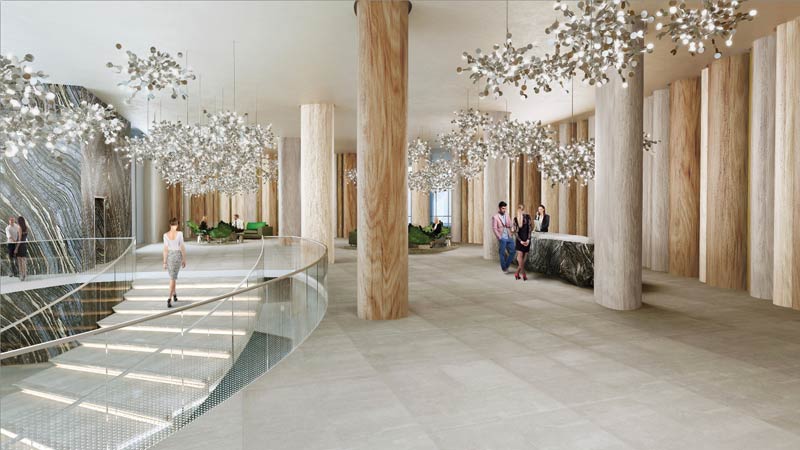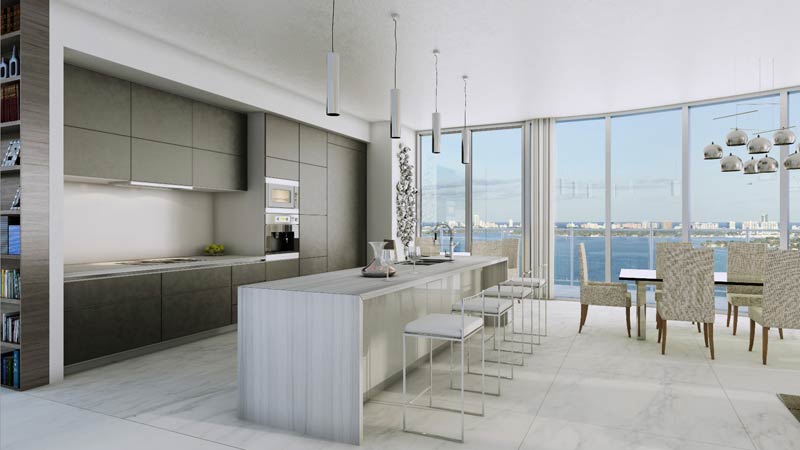Melo Group has launched sales for Aria on the Bay, a 647-unit luxury condominium in Miami. The bayfront condo will overlook Margaret Pace Park, Biscayne Bay, and the Miami Beach skyline. Construction is scheduled to begin in mid-2015, with completion slated for 2017, Architecture Lab reports.
Designed by Arquitectonica, the development is planned for the city's resurging Arts & Entertainment District. It will offer one-, two-, and three-bedroom condos, in addition to two-story penthouses. Prices range from $300,000 to $4 million; pre-construction reservations are now under way.
“More than a decade after delivering our first Miami tower we’re proud to be building our firm’s largest and most luxurious condo development to date,” Carlos Melo, a principal with the Melo Group, told Architecture Lab. “With the momentum building in the Arts & Entertainment District, Aria on the Bay will offer residents the opportunity to enjoy a walkable, family-friendly neighborhood surrounded by world-class cultural attractions.”
Aria on the Bay will be Melo Group's 14th tower in the greater Miami area.
Residents will enjoy private elevator access, floor-to-ceiling glass, spacious terraces, open-plan living areas, European-style kitchens, and custom cabinets.
The 14th floor will house a resort amenity deck with two curved lap pools featuring sunrise and sunset views, a children's pool, a hot tub, and a lounge area with fire pits, grills, and outdoor summer kitchens. In addition, Aria on the Bay will have 40,000 sf of commercial space in the lower floors, including office, retail, and restaurant space at the ground level.
Renderings courtesy of Arquitectonica and Melo Group.
Related Stories
| Aug 11, 2010
PBK, DLR Group among nation's largest K-12 school design firms, according to BD+C's Giants 300 report
A ranking of the Top 75 K-12 School Design Firms based on Building Design+Construction's 2009 Giants 300 survey. For more Giants 300 rankings, visit http://www.BDCnetwork.com/Giants
| Aug 11, 2010
Turner Building Cost Index dips nearly 4% in second quarter 2009
Turner Construction Company announced that the second quarter 2009 Turner Building Cost Index, which measures nonresidential building construction costs in the U.S., has decreased 3.35% from the first quarter 2009 and is 8.92% lower than its peak in the second quarter of 2008. The Turner Building Cost Index number for second quarter 2009 is 837.
| Aug 11, 2010
AGC unveils comprehensive plan to revive the construction industry
The Associated General Contractors of America unveiled a new plan today designed to revive the nation’s construction industry. The plan, “Build Now for the Future: A Blueprint for Economic Growth,” is designed to reverse predictions that construction activity will continue to shrink through 2010, crippling broader economic growth.
| Aug 11, 2010
New AIA report on embassies: integrate security and design excellence
The American Institute of Architects (AIA) released a new report to help the State Department design and build 21st Century embassies.
| Aug 11, 2010
Section Eight Design wins 2009 Open Architecture Challenge for classroom design
Victor, Idaho-based Section Eight Design beat out seven other finalists to win the 2009 Open Architecture Challenge: Classroom, spearheaded by the Open Architecture Network. Section Eight partnered with Teton Valley Community School (TVCS) in Victor to design the classroom of the future. Currently based out of a remodeled house, students at Teton Valley Community School are now one step closer to getting a real classroom.

















